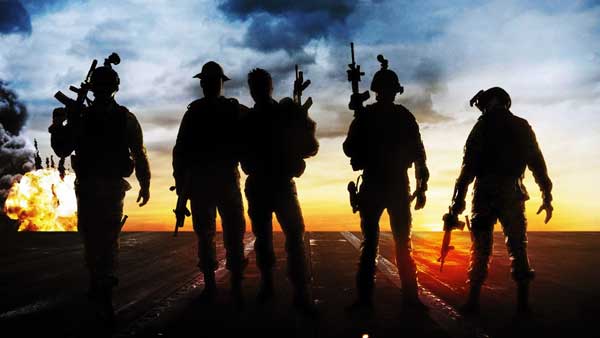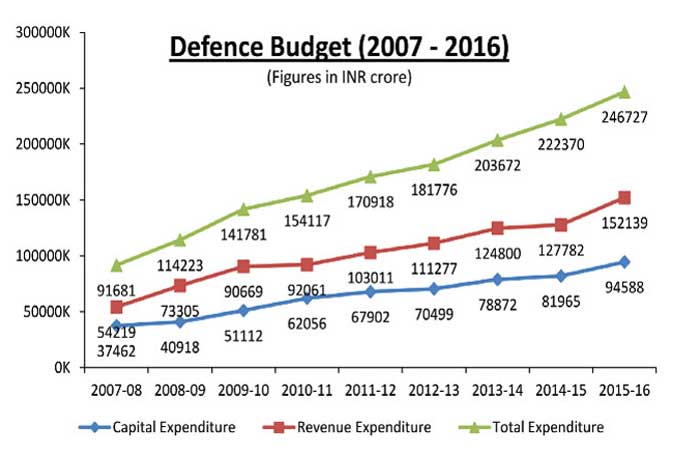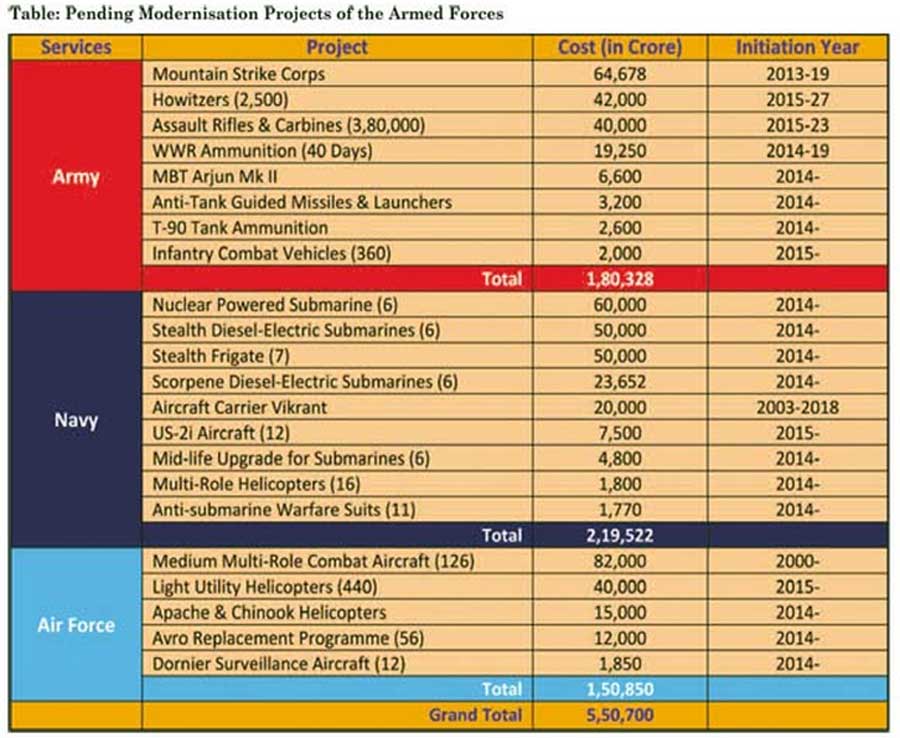Defence has got INR 2,46,727 crore (USD 40.07 billion), which is roughly 1.73 per cent of India’s Gross Domestic Product (GDP) and 13.88 per cent of the total Central expenditure. If this is compared to 2014-15 budget, defence allocation is up by 9.87 per cent.
The armed forces lost the cutting edge as their hardware gradually slid into obsolescence. No appreciable effort, monetary or otherwise was made by the then government to arrest this trend.
The period from 2004-14, as far as country’s defence preparedness is concerned, is considered as ‘lost decade’. The armed forces lost the cutting edge as their hardware gradually slid into obsolescence. No appreciable effort, monetary or otherwise was made by the then government to arrest this trend.
India’s defence needs, as more and more military hardware fell into the obsolescence black hole, have accumulated over the years. For instance, Indian Air Force (IAF) has come down to 25 fighter squadron strength from its authorised 45 squadron strength. It is worrisome that by 2024, when MiG 21’s and 27’s are phased out and new aircrafts are not inducted, IAF’s fleet of fighter aircrafts will shrink to mere 11 squadrons. Navy has inducted only one submarine to its fleet, while it has retired five in the last 15 years. It is operating vintage ships and submarines, whose seaworthiness is questionable and are accident prone. Army, which prides at being third largest standing army in the world, finds itself at the end of its tether due to chronic shortages of artillery guns, air defence equipment and ammunition. This revelation was not made by any doomsayer but by a Parliamentary panel in December 2014. Today, the Armed Forces have a large inventory of military hardware, which is urgently needed to restore parity, if not superiority with the arch rival Pakistan and pose a credible deterrence to China on the Northern borders and in the Indian Ocean.
On many occasions, India has articulated its intent to play a dominant role in South Asia, East Asia and Indian Ocean Region. Such aspirations were evident when Prime Minister Modi and US President Obama met in New Delhi in January this year. US wants India’s countervailing weight to rebalance Asian strategic tilt, while we are ourselves are concerned about rising Chinese influence in South Asia and Indian Ocean.
On February 28, when Union Finance Minister Arun Jaitley presented BJP-led NDA’s first independent Union Budget in the Parliament, the allocation for defence was anxiously awaited by the Armed Forces and country’s miniscule strategic fraternity. Defence has got INR 2,46,727 crore (USD 40.07 billion), which is roughly 1.73 per cent of India’s Gross Domestic Product (GDP) and 13.88 per cent of the total Central expenditure. If this is compared to 2014-15 budget, defence allocation is up by 9.87 per cent.
Every year a tidy sum from the defence budget is surrendered as ‘unspent’ to treasury. This year too, INR 6,630 crore have been returned.
61.66 per cent of the defence budget is meant for “Revenue” expenditure—catering to pay and allowances and other maintenance and operational needs. Balance 38.34 per cent allocation is earmarked to be spent on “Capital” expenditure. This pattern has remained unchanged over the years. Capital expenditure at INR 94,588 crore is incidentally identical to budget estimate (2014-15), which was later trimmed to INR 81,965 crore. On the face of it, it looks robust, but after reading the fine print, it is clear that the Army, Navy and Air Force get only INR 32,276 crore (34 per cent) for hardware procurement and payment of tranches for signed contracts.
Defence allocations in the Union Budget have remained stuck in a well-treaded groove. Sub two per cent allocations of GDP and below 10 per cent hike from the previous budget seem to have become a ritual dole from the finance ministry—irrespective of Armed Forces’ pressing needs or massive defence spending by China (USD 132 billion in 2014-15).
Defence procurement has been mired into procedural delays also. Every year a tidy sum from the defence budget is surrendered as ‘unspent’ to treasury. This year too, INR 6,630 crore have been returned. While the Armed Forces fuss over chronic shortages, their own procurement procedures and fiscal management leaves a lot to be desired.
India has been largest importer of arms since 2010. Prime Minister Modi’s thrust on indigenisation and “Make in India” makes sense. But, it is bound to affect forces’ modernisation. It is quite tempting to indigenise an inventory, which is worth 5,55,700 crore, but in the absence of high technology defence R&D and production base in the country the idea is not going fructify in the near future. This may further push the gestation period of defence programmes. India’s fixation with indigenisation is not new. We should stick to high technology sectors only and not try to make everything from ‘pins to planes’. Limit of the FDI in defence production, though raised from 26 to 49 per cent is yet to elicit favourable response from major armament industries. Overzealous thrust on indigenisation is bound to delay Armed Forces’ procurement plans further.
Defence Research and Development Organisation (DRDO) and Ordnance Factories are key to India’s indigenous defence R&D and production. It was expected that these establishments will receive a major allocation in their capital expenditures. But, it is not so. DRDO gets INR 7,788 crore—8.21 per cent more, while the Ordnance Factories have received INR 760 crore—up by 13 per cent from 2014-15 budget.
India has been largest importer of arms since 2010. Prime Minister Modi’s thrust on indigenisation and “Make in India” makes sense. But, it is bound to affect forces’ modernisation.
However, Border Roads Development Board has been allocated INR 3,063 crore for development of strategic roads in the border areas.
Under the present government there have been at least three defence acquisition council meetings in which military hardware worth INR 1,20,000 crore have been approved for procurement. Present budget does not make enough allocation for such procurement.
Pensions are not part of the defence budget; a separate allocation of INR 54,000 crore (more than 4,500 crore from previous budget) has been made. In the last budget, when the Finance Minister had allocated INR 1,000 crore to address ex-servicemen’s long standing demand of ‘one-rank-one-pension’, a hope has risen about its implementation in the current budget. He chose to remain silent on the issue, disappointing millions of veterans who are finding it difficult to make both ends meet on a meagre pension. While India does not want to initiate an arms race in the region, but it has to maintain strategic balance vis-a-vis Pakistan and China, for which modernisation is necessary. Funds are needed to modernise forces, mere rhetoric do not suffice. It is evident that the government has decided to go slow on defence modernisation and wait for Make in India to fructify. Repeated demand from Armed Forces and strategic fraternity for a defence budget which is three per cent of the GPD has been once again overlooked.
The defence budget falls short of expectations. It is insufficient to regain conventional parity with the adversaries or to place Armed Forces in the high technology orbit. Government’s nonchalance, despite debilitating shortages and strategic compulsions, is disappointing.








I will ask you two or three questions to Col US Rathore. Why do you require M777 field gun which has not got Shoot -and – Scoot ability like Bofors gun or Dhanush gun? How is the army going to save the Gun and the operators from weapon locating radars? Indian army selected Bofors instead of French gun because Indian Army got the Information that Pakistan got weapon locating radar. The only way to escape from enemies accurate return fire is to shift the gun to another place In the Kargil war most of the 80% of Indian casualties during the war resulted from enemy artillery fire, making such a radar critical.[6][8] , It is dangerous to use these guns in hilly areas. It is very difficult to get level surfaces in the hilly area like deserts. I never thought that the Chief of Army staff will help a corrupted govt to purchase guns unsuitable when the enemy has got weapon locating radars. China has got WLR. I have not seen a single photo using M777 in hilly areas.
Where did you get the figure of 45 squadrons?
Can you tell me how many planes you have calculated per Squadrons?
How are you telling the total number of squadrons to come down to 25 when IAF Chief is telling 33 squadrons if we calculate 18 fighter plane per squadrons. IAF has got SU-30 MKI 272 numbers for replacing of Mig 21.
The majority of your demand is not based on actual requirement. So defence budget is base on actual requirements not on GDP. M 777 is a clear example and blame others. You people won’t give value to an Ex. Chief decisions. No sensible person will purchase M 777 after reading the two articles given below.:-
“‘I said for national honour we should go to the extreme of cancelling the contract'”.
The Rediff Interview General K Sundarji
‘The army and I are being made scapegoats in the Bofors drama’
Do not try to throw the responsibility on others. This is 21st century and not 20th century. We will get every information from the internet.
Rather than considering the quantity of budget, the quality of the budget in terms of the effectiveness of security accomplishment should be considered. Over the decades, India’s tail has grown in quantity as well as ranks and perquisites leaving an overly expensive yet ineffective force equipped with rifles that jam, inadequate high altitude equipment, obsolete mines unfit for contemporary static, all weather, battle fields, obsolete air craft carriers suited to patrol the skies over North Karnataka, Light Combat Aircraft that are built of bricks, mortar and concrete in Bangalore’s suburbs and so on. The armed forces need to define threat perceptions and scenarios to derive multi theater and multi dimensional battle and war scenarios and re engineer the armed forces accordingly so as to cut the coat to suit the cloth. In other words, given the budget India can afford over the next ten years, in the form of a rolling plan, India needs to slough the tail, including the ceremonial and the traditional while sharpening and adding teeth to achieve victory. But then, the Civilian Over Lords of the Armed Forces have stamped it with their incompetent and corrupt authority where the symbolism of RD Parades and Fleet Reviews and the fattening of the Armed Forces with meaningless perks, privileges and comforts are far more important than war fighting equipment, medical services, gear, weapons and ammunition, or even the psychological comfort of security and good prospects for the families and the bereaved of those “paid to die”.
Can you tell me what do you mean by inadequate high altitude equipment? Do you know the purpose of Aitcraftcraft? Being a Bhramin you will be knowing the meaning of
” Loka Samastha Sukhino Bhavanthu”. But do you believe and lead life accordingly. Indian Govt following this policy. Aircraft carriers are being used to attack far away countries to loot their wealth when the fight planes or missiles have no range, So it is will carry fighter plane to the nearest port. We have no plan to attack any country.
The majority of defence officers are good in fighting but weak in war strategy and poor managers. Can the fighter planes be made out of bricks? So you are very weak in technical matters and war strategy.